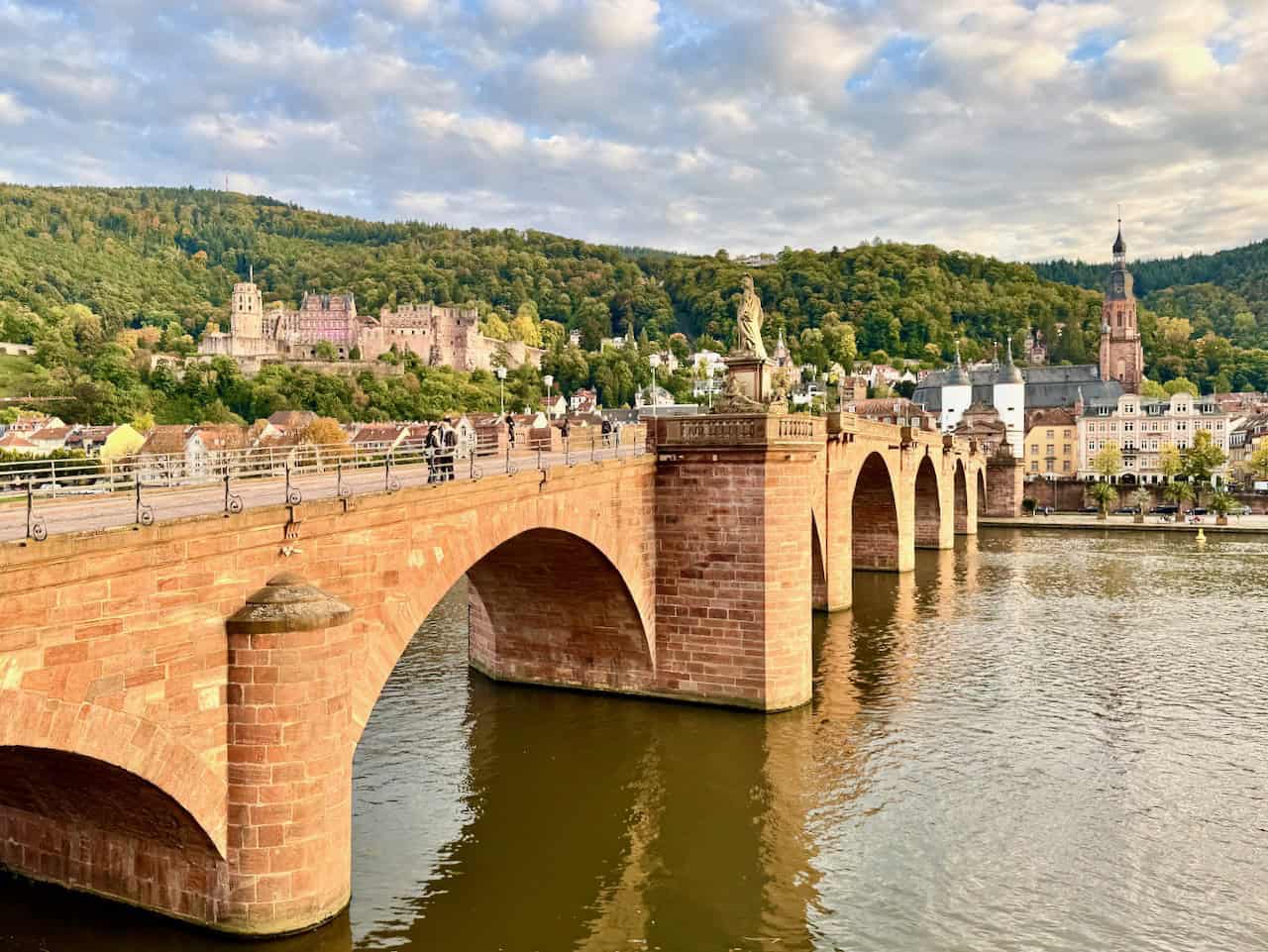
Beautiful landscapes, charming history-rich towns, varied architecture and delicious food and wines are elements I seek out most when I plan my travels. One country that effortlessly combines these elements is Germany. It’s one reason I visit so often – in addition to the fact that I live ‘next door’ in The Netherlands. I recently experienced this perfect combination during a rail tour in western Germany. Starting in Amsterdam, I made my way down to Koblenz before continuing to Trier, Heidelberg and Wiesbaden. This six-day trip followed the path of the Rhine River and its tributaries, the Mosselle and Neckar.
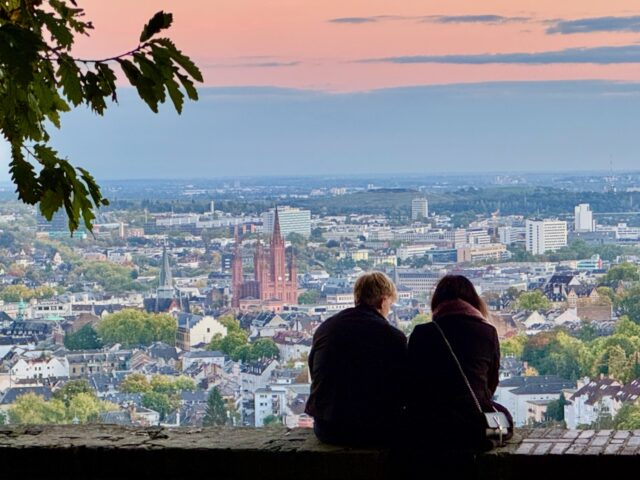 Panoramic view of Wiesbaden from Neroberg
Panoramic view of Wiesbaden from Neroberg

There are many great reasons to visit Germany and one point that stands out is its vast rail network. This network makes it easy for travellers to visit almost every part of the country. For this trip, I combined booked seats on the ICE (InterCity Express high-speed trains) with the Deutschland Ticket, a monthly subscription ticket (€58/month) which covers unlimited travel on regional rail lines and local public transport.
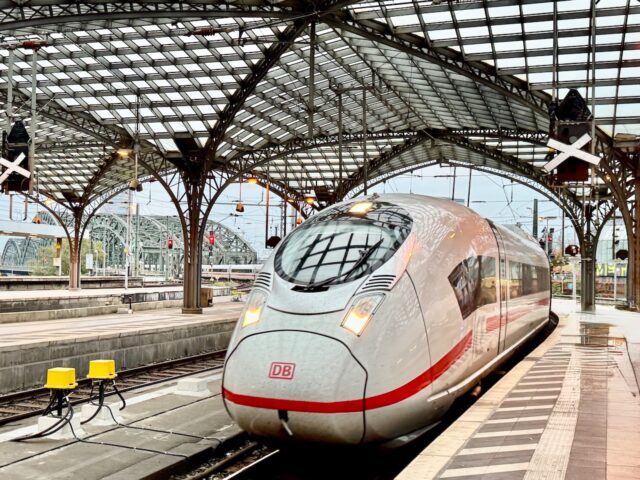 ICE high-speed train
ICE high-speed train
Rail trip along the Rhine and Mosselle: 6-day itinerary
From Amsterdam, I boarded the ICE train to Cologne, where I connected to a regional line to Koblenz. The next day, I boarded a regional train to Trier, a scenic route that follows the path of the Mosselle River. After two nights in Trier, I continued my trip to Heidelberg via Mannheim – the Trier to Mannheim stretch, along the Saar River, is especially beautiful. From Heidelberg, it was a quick hop to Wiesbaden where I spent a night before returning to Amsterdam.
- Day 1: Amsterdam to Koblenz (via Cologne)
- Day 2: Koblenz in the morning; train to Trier in the late-afternoon
- Day 3: Trier
- Day 4: Trier to Heidelberg (via Mannheim)
- Day 5: Heidelberg in the morning; train to Wiesbaden in the late-afternoon
- Day 6: Wiesbaden in the morning; train to Amsterdam in the late-afternoon
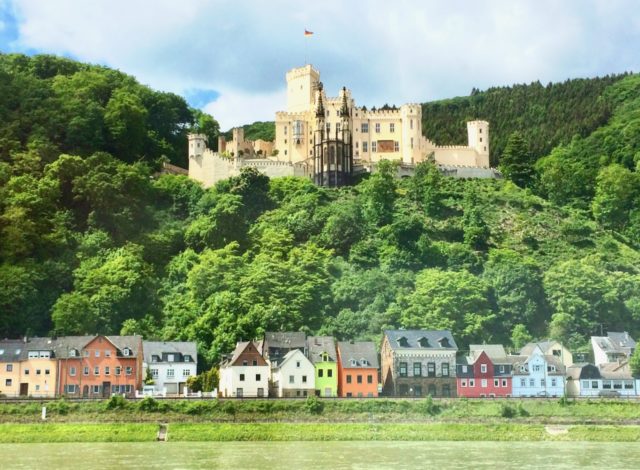 Stolzenfels Castle near Koblenz
Stolzenfels Castle near Koblenz
This rail trip through western Germany, a collaboration with Historic Highlights of Germany, was full of the things I enjoy most when I travel: stunning historic cities, lush landscapes and nature, beautiful architecture and amazing food and wines! The cities I visited have so much to offer and are best enjoyed at a slower pace. Here are my highlights in each city:
Koblenz
Strategically located at the point where the Mosselle meets the Rhine, Koblenz (map) has a history that dates back to Roman times. At the confluence of the rivers, Drusus founded a military post (9 B.C.) to fend off attacks by the Franks. The Romans built a bridge across the Rhine, remnants of which can still be seen today.
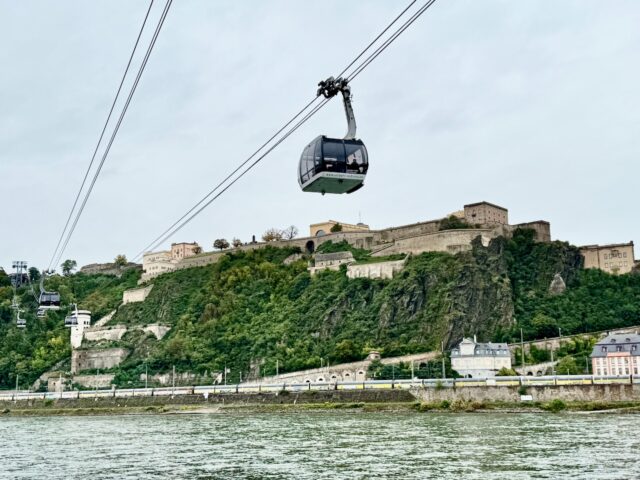 Cable car to Ehrenbreitstein Fortress
Cable car to Ehrenbreitstein Fortress
Its strategic location meant that Koblenz remained an important asset that numerous powers vied for over the centuries: from the Franks to the French and the Russians to the Prussians! To learn more about this rich history, I recommend visiting the Koblenz tourist office at Zentralplatz which has a large interactive, touchscreen TV. I also suggest visiting the Archeological Museum inside the Ehrenbreitstein Fortress, which has an impressive collection of artifacts.
The city was heavily bombed during WWII and was subsequently restored. In 2002, UNESCO declared the Rhine Gorge, with Koblenz as its northern boundary, a World Heritage Site.
Highlights of Koblenz
Upon my arrival in Koblenz, I checked into the Four Points Flex by Sheraton hotel next to the central station (Koblenz Hauptbahnhof). The first thing on my itinerary was a guided visit to Weingut Göhlen (map), a lovely, family-owned winery near the foot of the Ehrenbreitstein Fortress. While there, I got to tour the cellar and taste the wonderful wines from this estate. The Ehrenbreitsteiner Spätlese and Weissburgunder wines were my favourites.
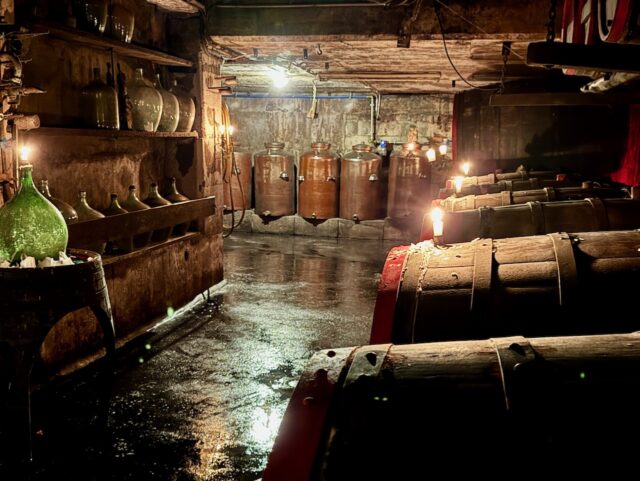 Cellar at Weingut Göhlen
Cellar at Weingut Göhlen
That evening, I had a terrific dinner at Wirtshaus Alt Coblenz, a cosy restaurant in the old town that serves delicious local specialties and wines.
Koblenz Old Town and Ehrenbreitstein fortress
The next morning, I set out to explore Koblenz’s Old Town, where the main attractions are all within easy walking distance. Highlights include the Liebfrauenkirche, a stunning 12th-century church blending Romanesque, Gothic, and Baroque styles; Kunstgässchen, a charming medieval lane lined with shops; and the Schängel Fountain, a bronze statue of a boy spitting that has become something of a city icon.
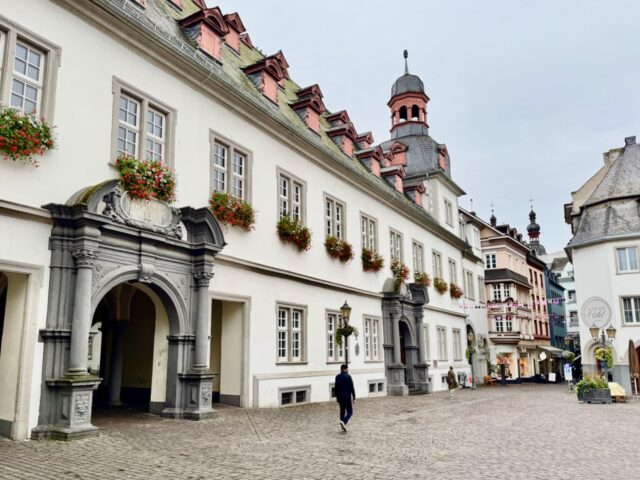 Koblenz Old Town
Koblenz Old Town 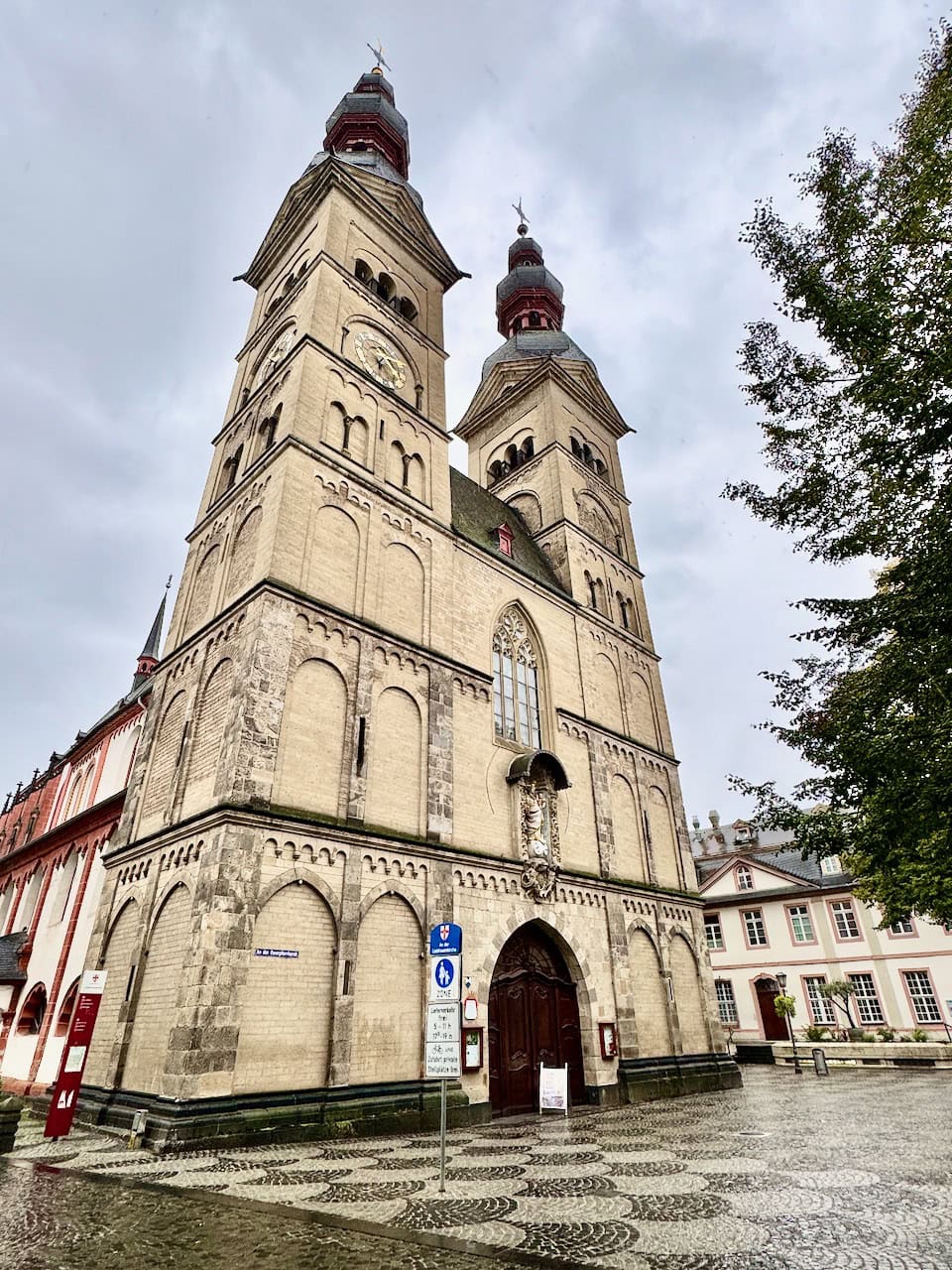 Church of Our Lady
Church of Our Lady 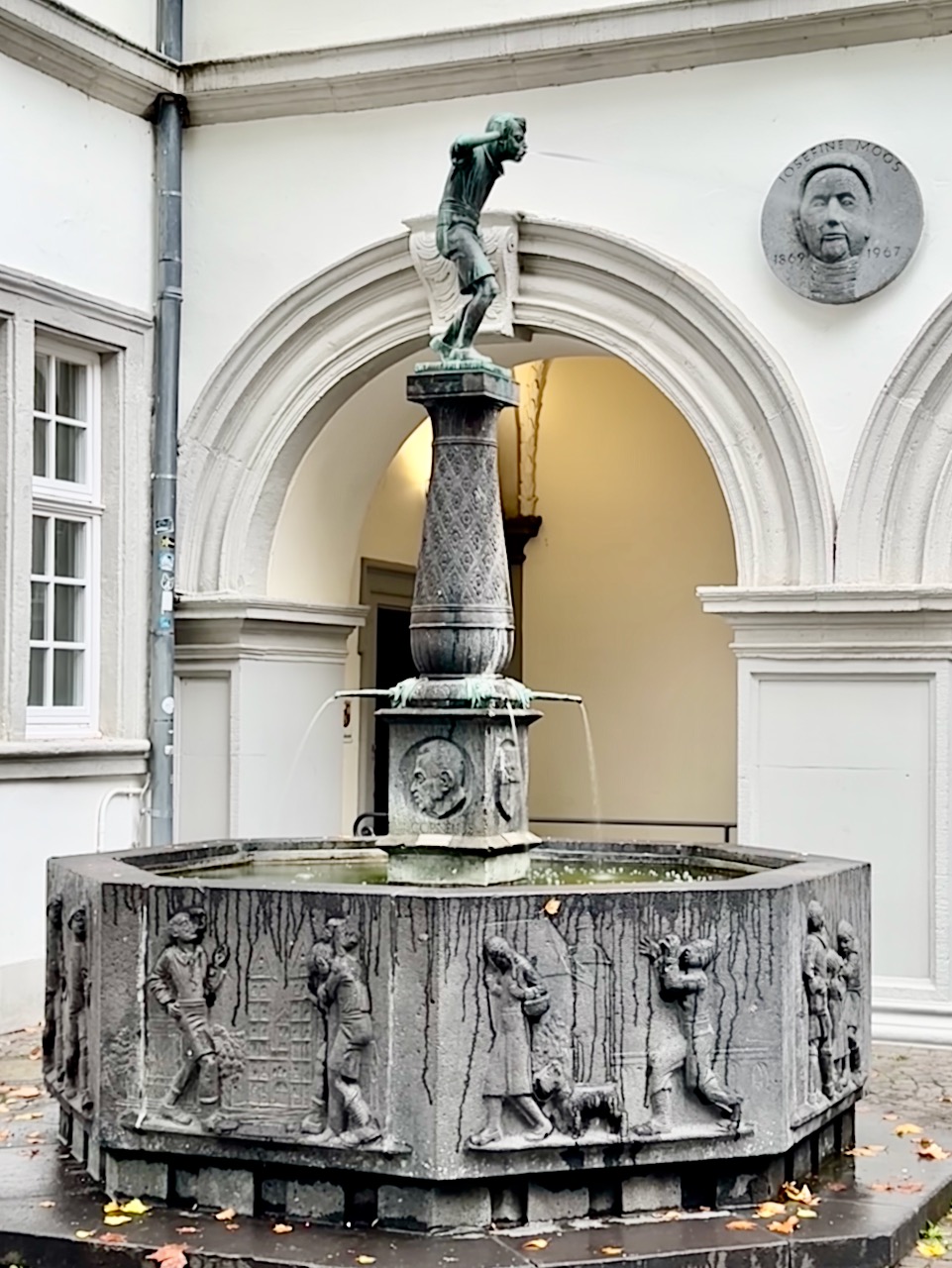 Schängel Fountain
Schängel Fountain
I also visited the History Column on Josef-Görres-Platz, a towering monument depicting Koblenz’s past, strolled along the scenic Rhine promenade, and admired the imposing Prussian government building at the riverfront.
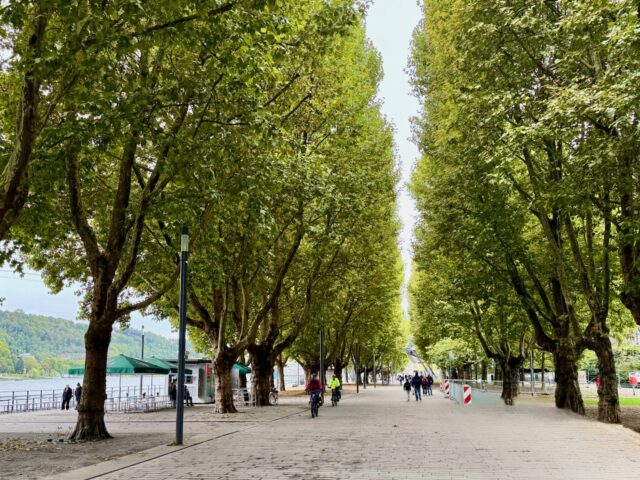 Rhine promenade
Rhine promenade
No visit would be complete without seeing the Deutsches Eck. An impressive monument to Emperor Wilhelm I, it sits at the confluence of the Rhine and Moselle rivers. Nearby, the Basilica of St. Castor, a 13th-century Romanesque church, is also worth a visit. Visit the Koblenz Tourism website for more info.
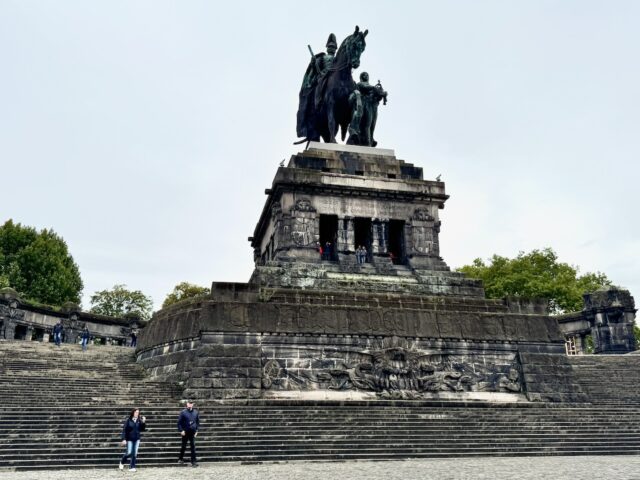 Deutsches Eck
Deutsches Eck 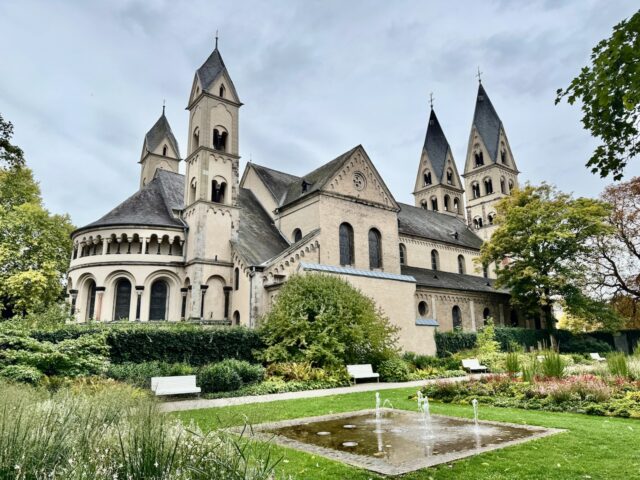 Basilica of St. Castor
Basilica of St. Castor
In the afternoon, I took the cable-car across the Rhine to the Ehrenbreitstein fortress. I absolutely enjoyed the ride, which offers gorgeous panoramic views of the city. Built by the Prussians in the 19th century, the fortress is a formidable sight.
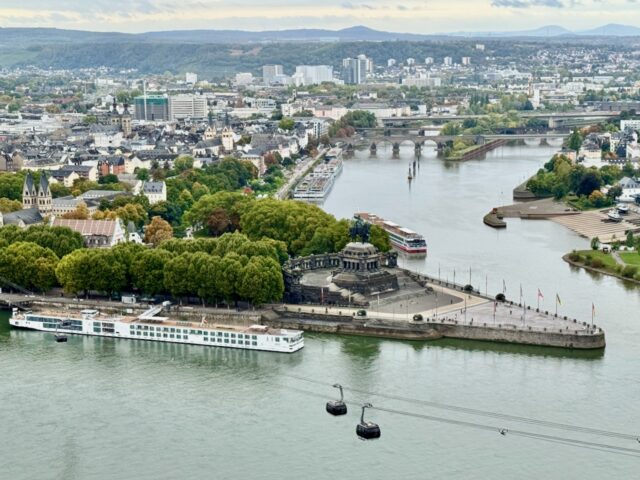 Panoramic view of Koblenz at the confluence of the Rhine and Mosselle rivers
Panoramic view of Koblenz at the confluence of the Rhine and Mosselle rivers
Trier
The next stop on my western Germany rail tour was Trier (map), often hailed as Germany’s oldest city and renowned for its remarkable Roman heritage. It’s truly astonishing to encounter such grand Roman structures so far north, a testament to Trier’s strategic importance and prosperity during the Roman era.
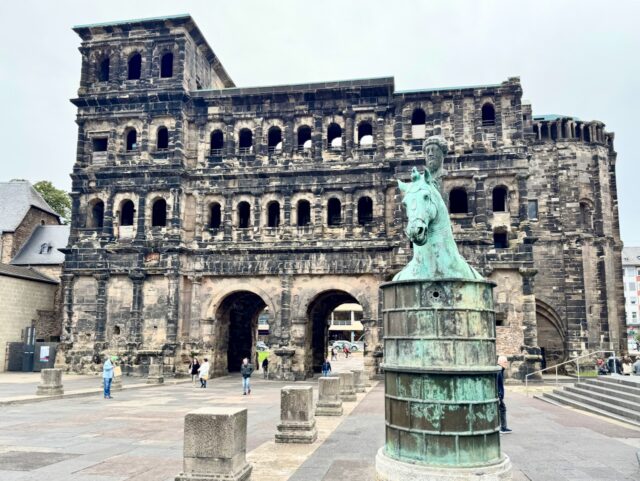 Porta Nigra, the Roman gate
Porta Nigra, the Roman gate
The train ride from Koblenz along the Moselle River offered scenic views of rolling hills, vineyards, and castles. In Trier, I spent two nights at Hotel Porta Nigra Victus, near the city’s iconic Porta Nigra gate.
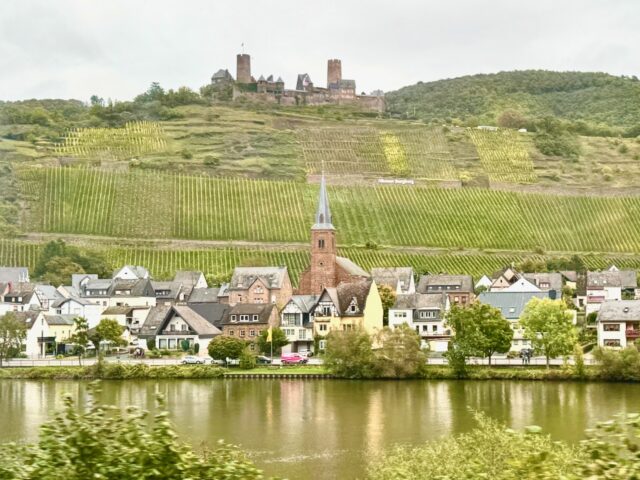 Beautiful scenery along the Mosselle River
Beautiful scenery along the Mosselle River
Aside from its Roman monuments, Trier is also famous for its wines due to its central location in the Mosselle wine region. At the city’s Hauptmarkt (main square), I found Weinstand, a booth that showcases the region’s wines. Local wineries take turns to man the booth and serve their best wines, a really cool place that’s popular amongst both locals and visitors.
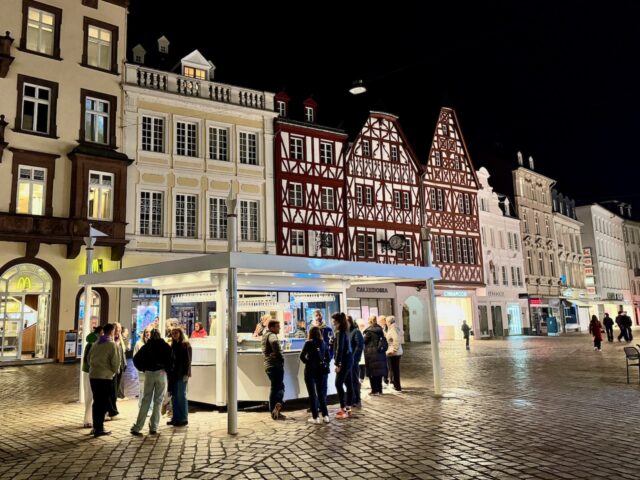 Weinstand Trier at Hauptplatz
Weinstand Trier at Hauptplatz
There are also numerous wine taverns (weinstube) scattered across the city that serve traditional cuisine and local wines. One I can recommend is Weinstube Kesselstatt, an atmospheric restaurant near the Cathedral.
The Roman monuments of Trier
Trier was founded by the Romans in the 1st century B.C. as Augusta Treverorum. The most famous and extensive Roman structures in Trier are the Porta Nigra (an impressive gate that was once part of the city’s fortifications), Aula Palatina (the Throne Hall of Constantine), the Amphitheater, Trier Cathedral, Roman Bridge and several Roman baths, the largest of which are the Imperial Baths. These are now UNESCO World Heritage monuments. The Trier tourist office issues a single ticket (AntikenCard) which covers entrance to 2 or 4 of these monuments as well as the Rhineland State Museum.
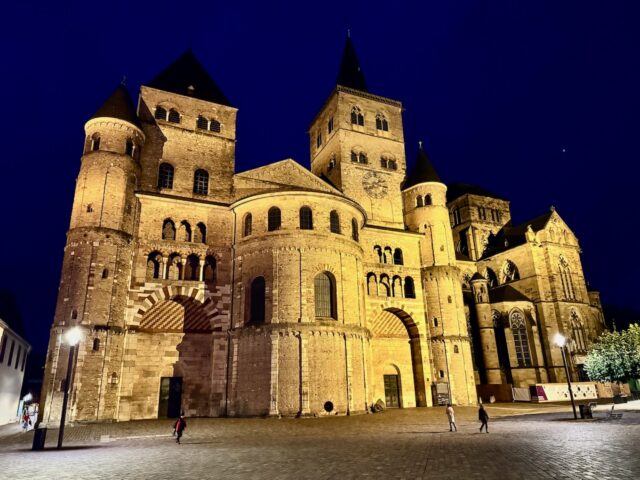 Trier Cathedral at night
Trier Cathedral at night 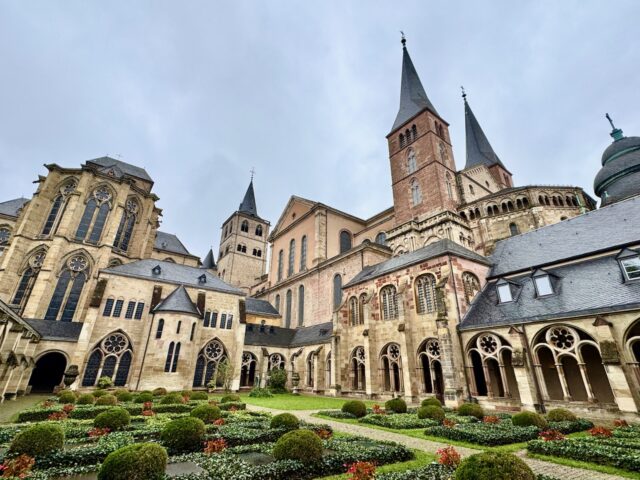 Trier Cathedral cloister
Trier Cathedral cloister 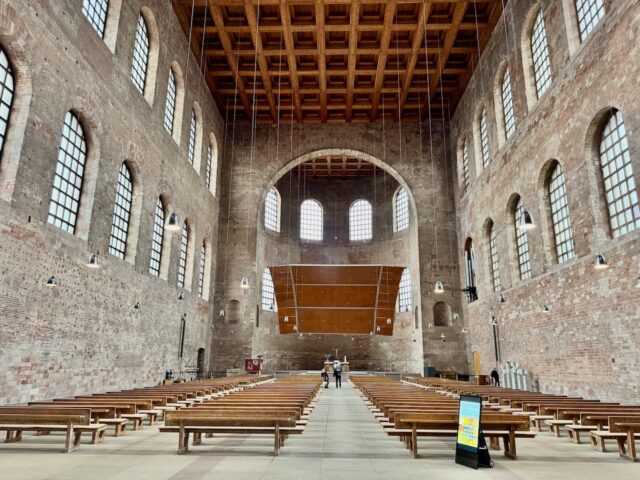 Aula Palatina, the Throne Hall of Emperor Constantine
Aula Palatina, the Throne Hall of Emperor Constantine
Standing before the Porta Nigra, I found myself wondering why a Roman city gate would have what looked like an apse attached to its side. My guide soon explained: over the centuries, many ancient monuments were repurposed. Some became foundations for new buildings, while others were transformed into churches.
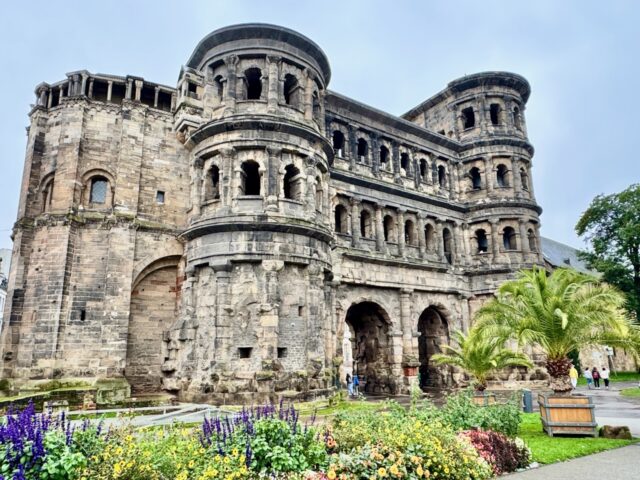 The apse (left) attached to the Porta Nigra gate
The apse (left) attached to the Porta Nigra gate
The role of Napoleon Bonaparte
In fact, Trier’s Roman monuments might not even be visible today were it not for Napoleon Bonaparte. During his visits to the city, he recognised the Roman structures hidden beneath medieval additions and ordered the demolition of the ‘newer’ layers to restore the ancient sites to their former glory. So, although the Porta Nigra appears to be a gate, subtle traces of the basilica it once became still remain.
These layers of history are also evident in Trier Cathedral, the oldest cathedral in Germany. Its construction began in Roman times, and over the centuries, new additions were made in the Romanesque and Gothic styles. The contrast between these architectural periods is easy to spot, whether from the street, particularly along the north façade, or from the peaceful cloister gardens.
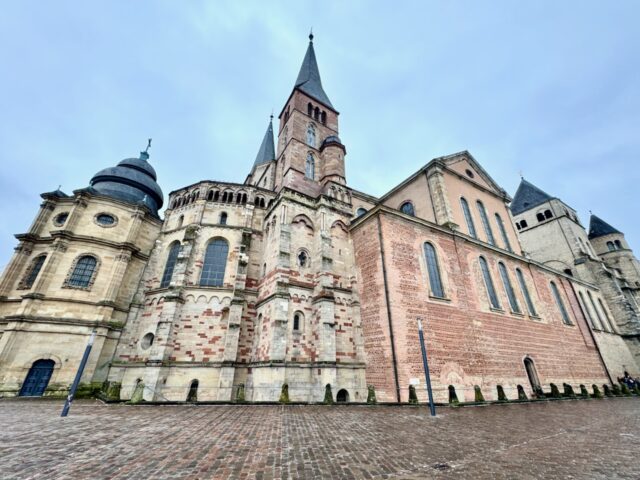 The north façade of Trier Cathedral
The north façade of Trier Cathedral
Highlights of Trier
I spent a full day exploring the city. Aside from the amazing Roman monuments, I enjoyed the city’s medieval heritage, charming squares and surrounding forest- and vineyard-clad hills. The highlights for me were the Porta Nigra, Trier Cathedral, the Church of Our Lady, Aula Palatina and the adjacent Electoral Palace, and the Imperial Baths.
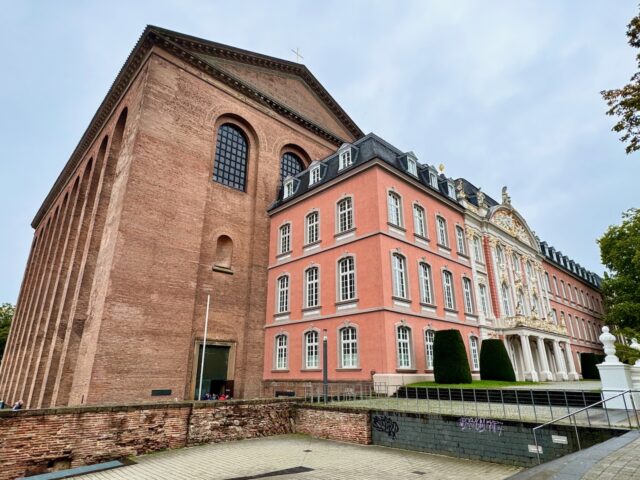 The Electoral Palace (right) was built adjacent to Aula Palatina (left)
The Electoral Palace (right) was built adjacent to Aula Palatina (left)
In addition, I loved the Hauptmarkt, a medieval square lined by beautiful houses. The incredible exhibits in the Rhineland State Museum, that includes the largest collection of Roman coins, were also a highlight. Visit the Trier Tourism website for more info.
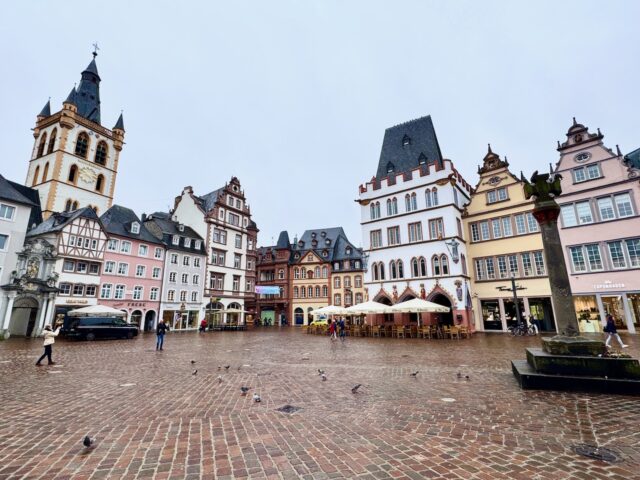 Hauptmarkt
Hauptmarkt 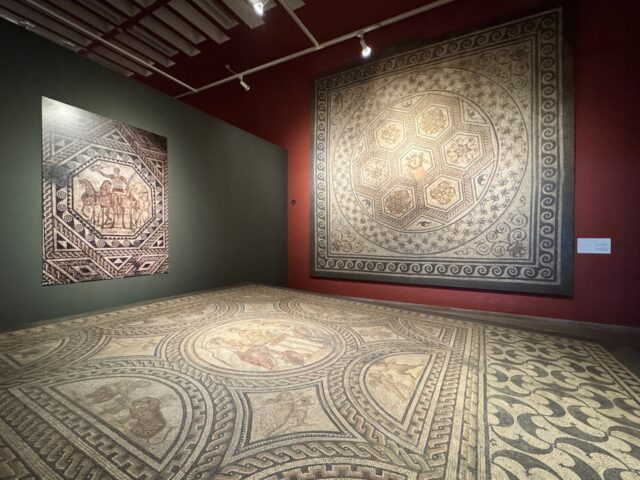 Roman mosaics at the Rhineland State Museum
Roman mosaics at the Rhineland State Museum
I also enjoyed walking along the serene Mosselle River to Zurlaubener Ufer, a charming riverside neighbourhood packed with restaurants and cafés. Along the way, I passed the Roman Bridge and several 18th century cranes which were used to load and unload wines and other goods from river barges.
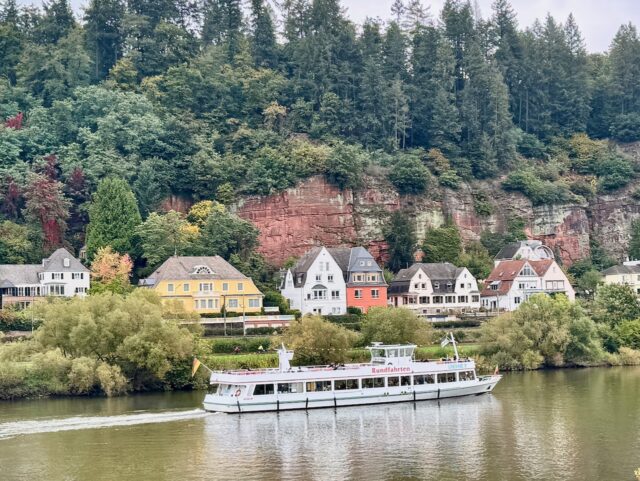 Mosselle River
Mosselle River
Another highlight for me was an insightful wine-tasting at the Goldmund Wine Store (map). I was especially impressed by how the proprietor showcases local wines and their makers. I recommend booking a wine-tasting session in advance.
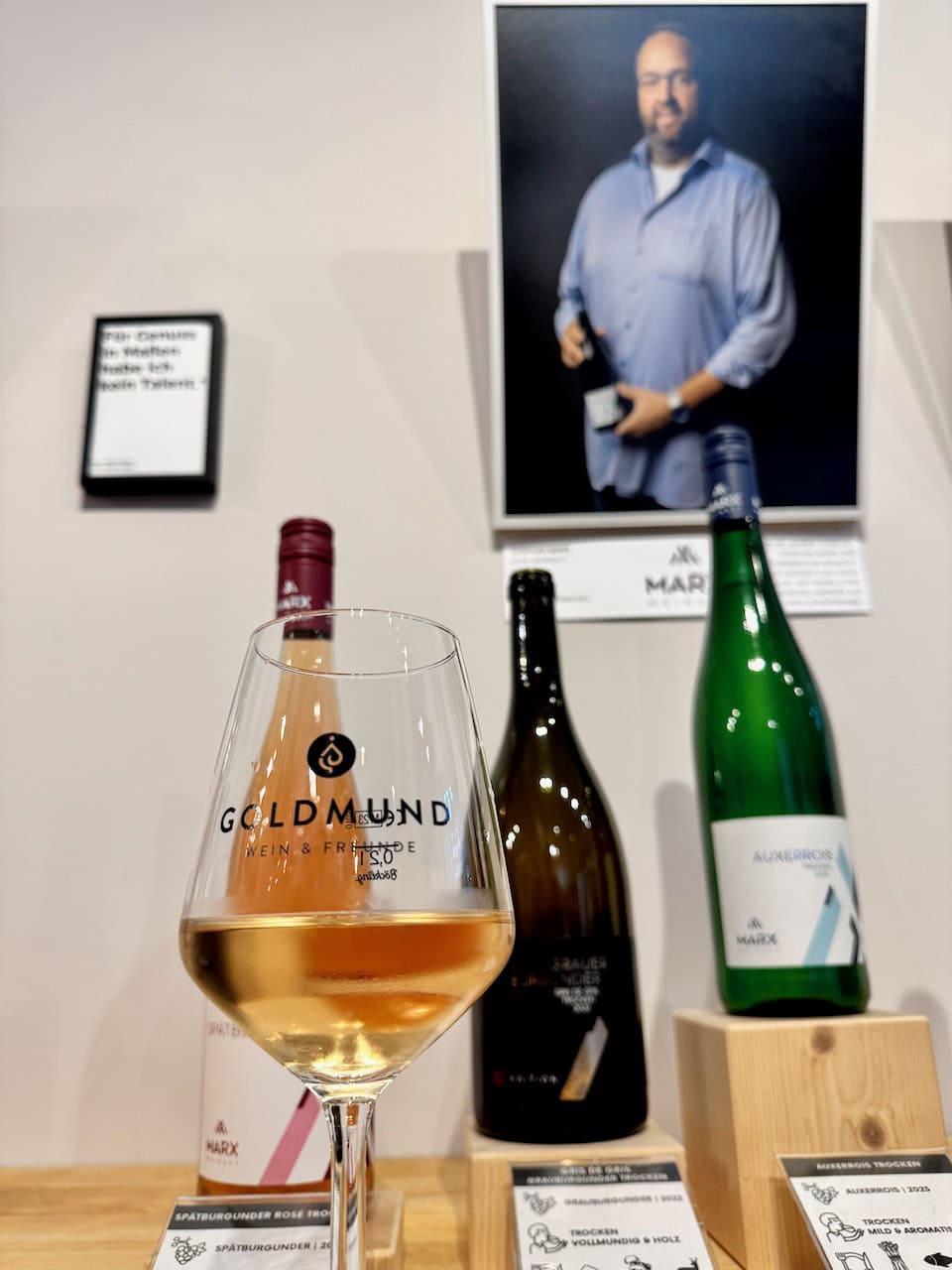 Wine-tasting at Goldmund Wines
Wine-tasting at Goldmund Wines
Heidelberg
My next destination, Heidelberg (map), wasn’t new to me. In fact, I’d visited twice before: once on a road trip and again as a stop on a Rhine River cruise. This third visit only deepened my affection for the city: its breathtaking setting, picture-perfect Old Town, and vibrant cultural life never fail to captivate me.
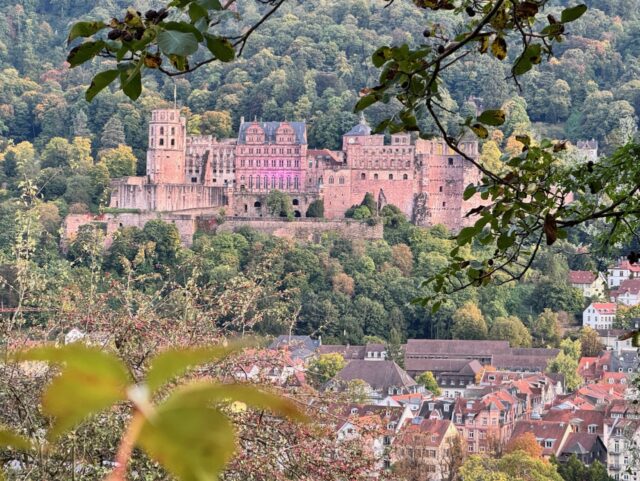 Heidelberg Castle
Heidelberg Castle
Perched on the banks of the Neckar River, a tributary of the Rhine, Heidelberg guards the narrow entrance to the Neckar Valley. Its two iconic landmarks – Heidelberg Castle and the Old Bridge – stand as enduring testaments to this strategic location.
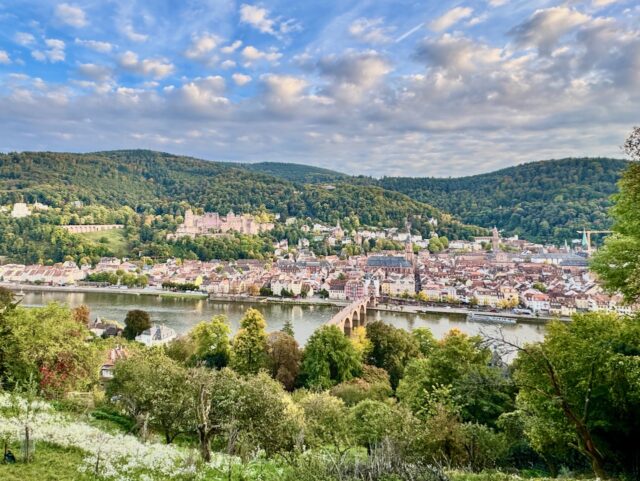 Panoramic view of Heidelberg
Panoramic view of Heidelberg
Heidelberg station (Hauptbahnhof) is located quite a distance from the old town so I used my Deutschland Ticket for the 15-minute bus ride. Once in the old town, I checked into the lovely Hotel Höllander Hof. My room had a stunning view of the Old Bridge and the hills!
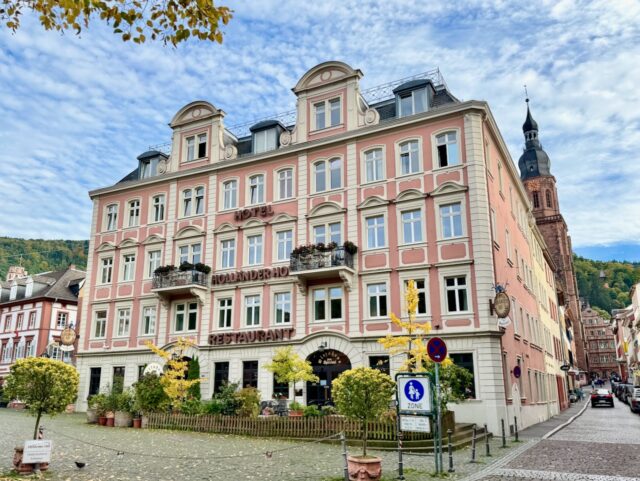 Hotel Höllander Hof
Hotel Höllander Hof 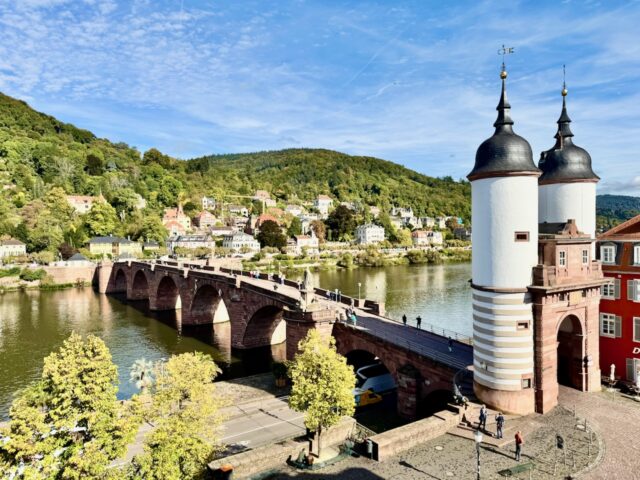 The view from my room
The view from my room
First up was a fantastic lunch at the nearby Schnookeloch restaurant, where the generous portions were perfectly matched by the rich, delicious flavours.
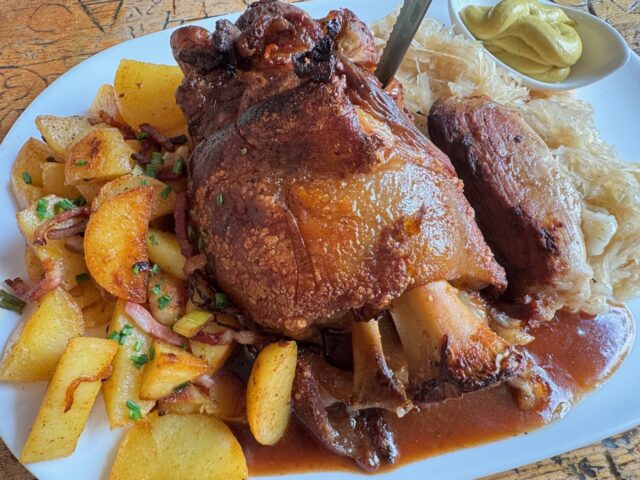 Hearty German cuisine at Schnookeloch
Hearty German cuisine at Schnookeloch
This was followed by a whirlwind exploration of Heidelberg on foot. Easy to do as the old town, where many of the main attractions are located, is compact. Together with my guide, I decided to add on places I’d not been to before, including a hike to a panoramic viewpoint.
Highlights of Heidelberg
The top things to do in Heidelberg include wandering through the charming streets and squares of the Old Town, crossing the historic Old Bridge, and visiting the atmospheric ruins of Heidelberg Castle.
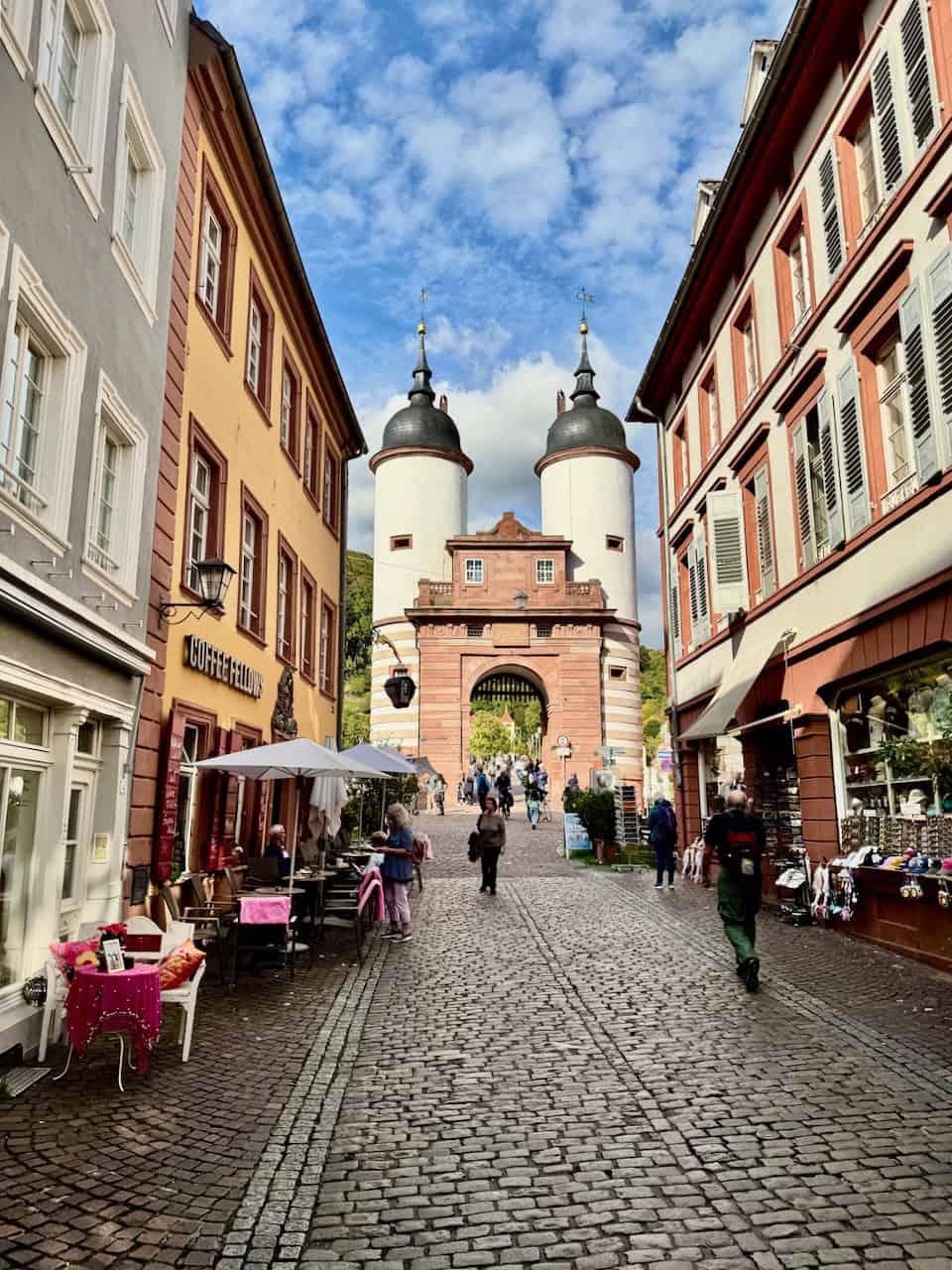 Heidelberg Old Town
Heidelberg Old Town 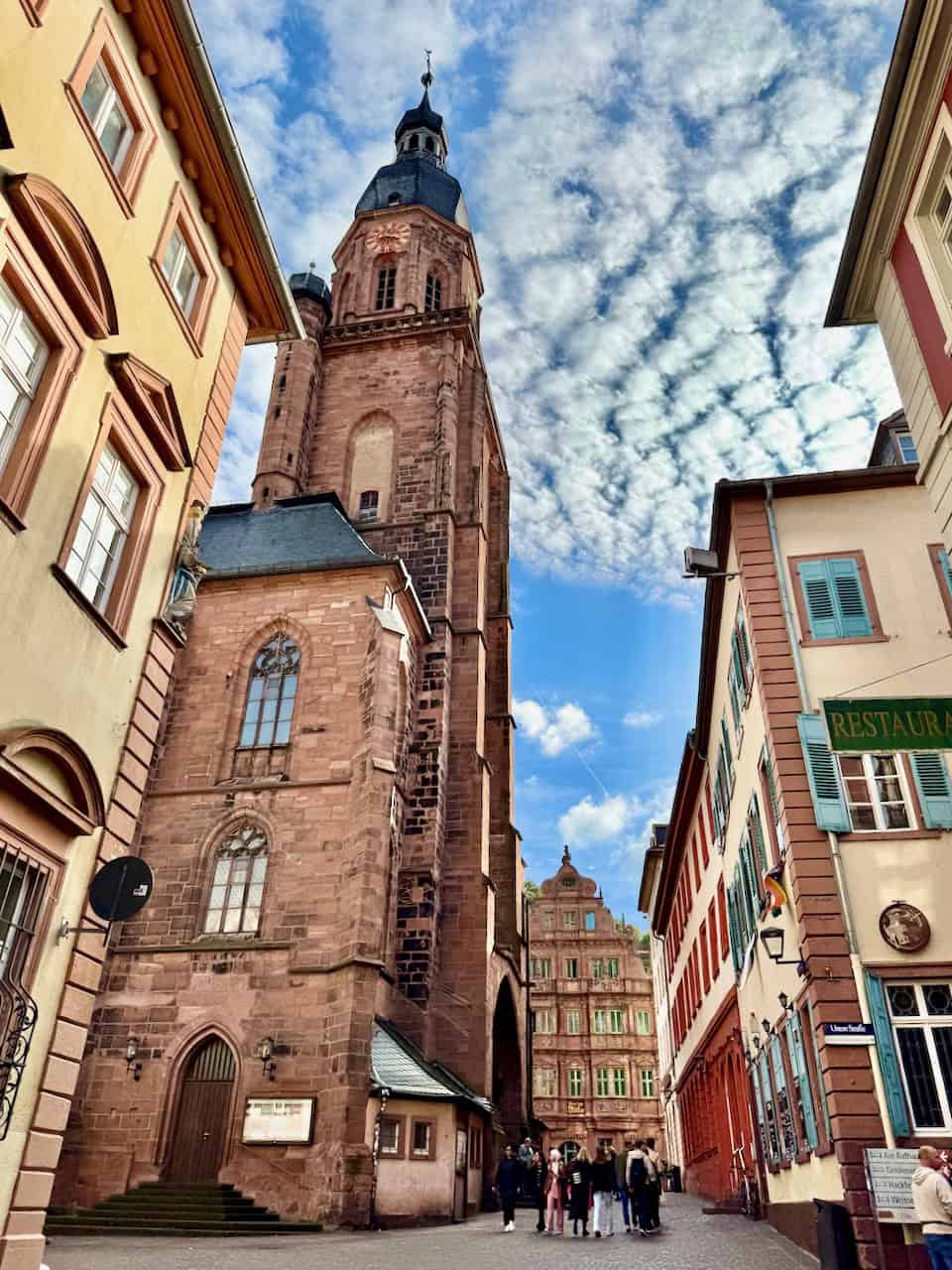 Church of the Holy Spirit street view
Church of the Holy Spirit street view
My personal highlights were the lively Marktplatz, hiking up the Schlangenweg for breathtaking panoramas, and visiting the Student Prison, whose fascinating history even inspired Mark Twain to pay for a night’s stay.
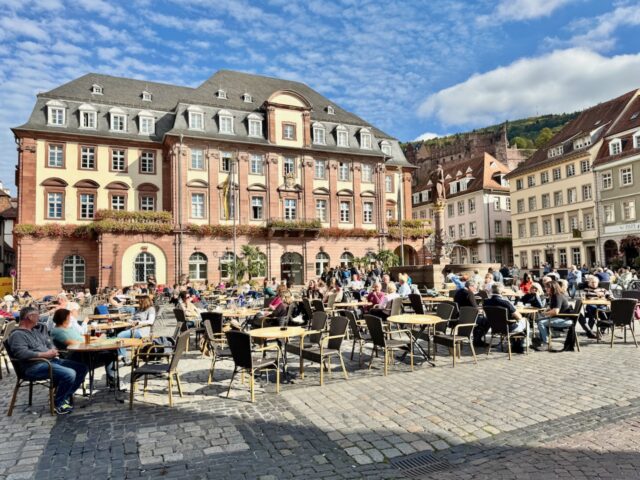 Marktplatz
Marktplatz 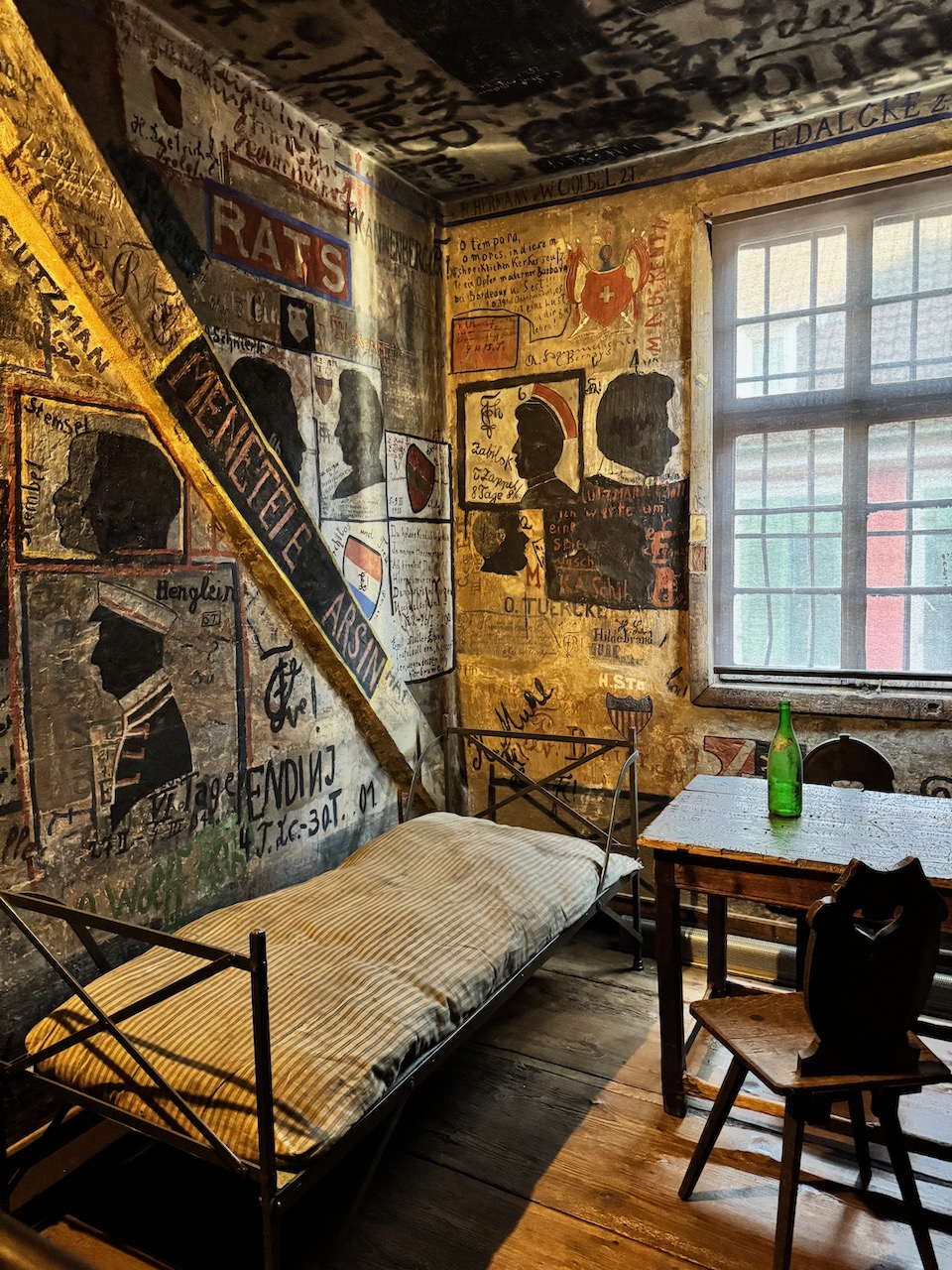 Student Prison
Student Prison
I also loved stepping inside the Grand Aula at the University, exploring the castle grounds, and taking the antique funicular up to Königstuhl for a delightful lunch at Berggasthof Königstuhl. Visit the Heidelberg Tourism website for more info.
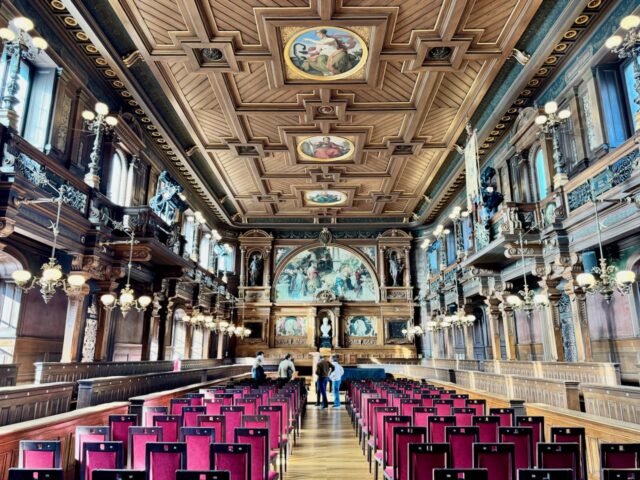 Grand Aula at the University of Heidelberg
Grand Aula at the University of Heidelberg 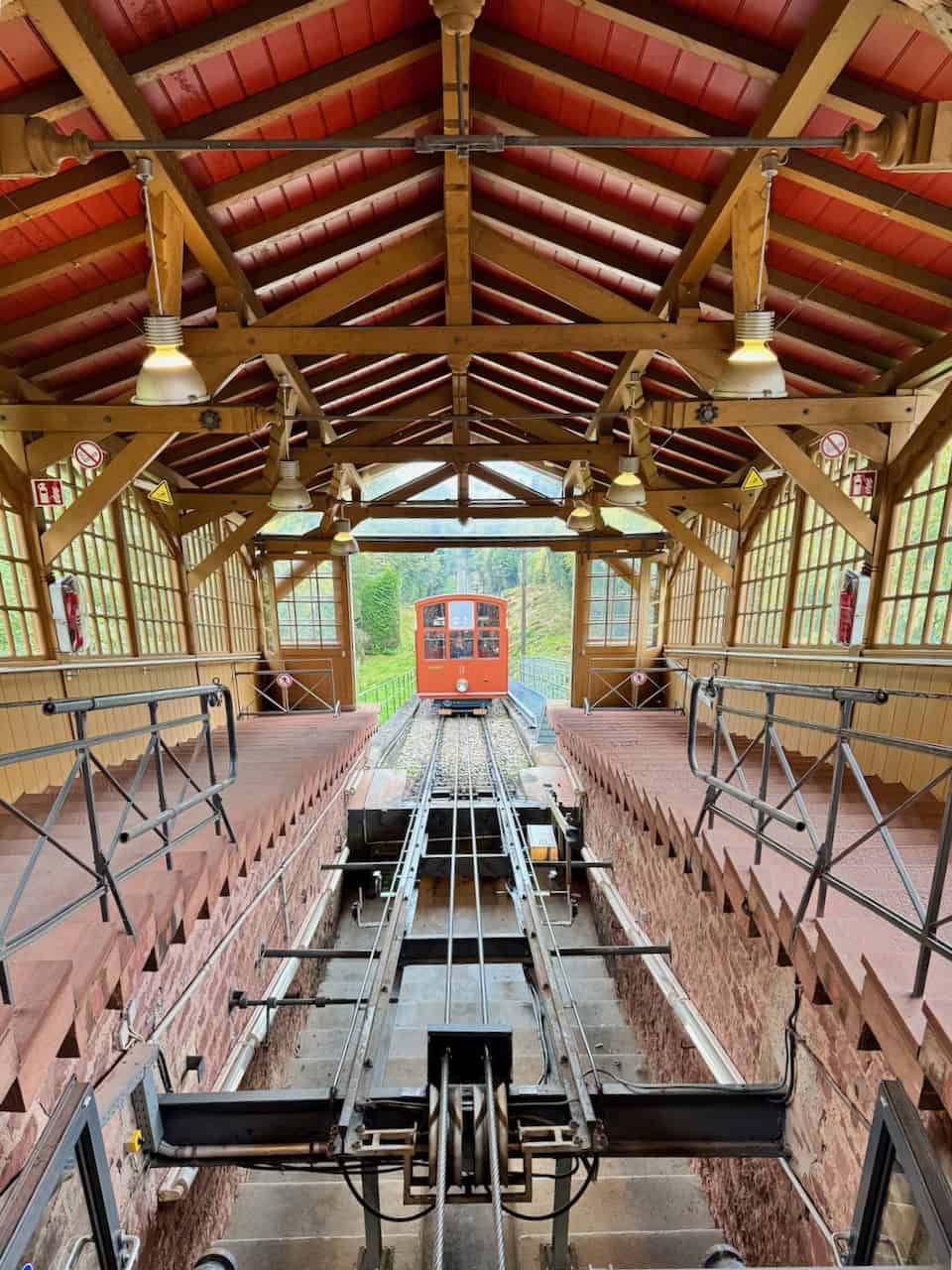 Königstuhl funicular
Königstuhl funicular
Wiesbaden
Of the four cities on my itinerary, Wiesbaden (map) turned out to be the biggest surprise. I’d passed it numerous times by car and train, yet it had never once occurred to me to stop and explore. By the time I left, I couldn’t help but wonder if Wiesbaden might just be Germany’s best-kept secret!
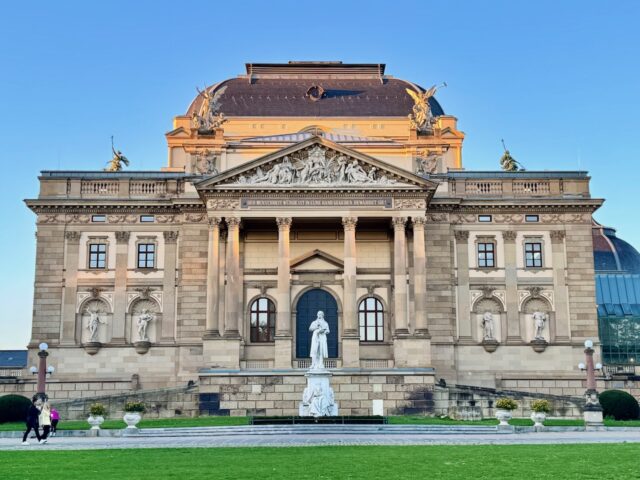 Wiesbaden Staatstheater
Wiesbaden Staatstheater
Wiesbaden, the capital of the state of Hesse, is one of the oldest spa towns in Europe. Blessed with 15 mineral springs, it became a fashionable retreat for Europe’s elite in the 19th and 20th centuries. To cater to these distinguished visitors, grand palace-like hotels and elegant villas were built. Expansive parks and gardens were designed for leisurely strolls and social gatherings. The city flourished at the turn of the 20th century, as Europe’s nobility – especially aristocrats from Austro-Hungary and Russia – followed Emperor Wilhelm II’s example by spending their summers in Wiesbaden.
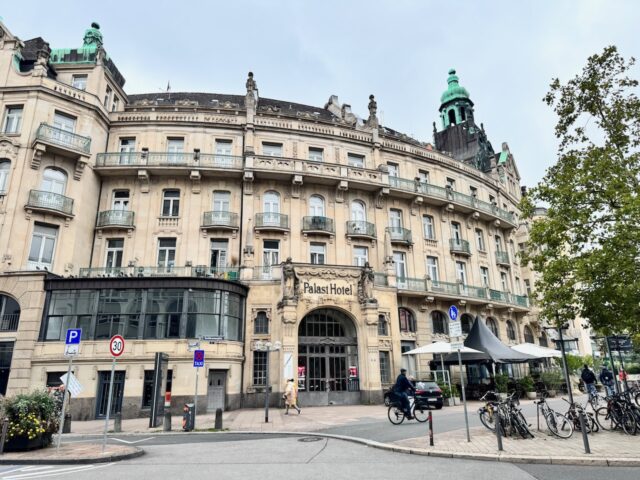 One of the numerous grand spa hotels
One of the numerous grand spa hotels
These days, Wiesbaden still oozes this timeless elegance. Visitors come to enjoy the spas, shop at exclusive boutiques, visit the museums and try their luck at the atmospheric casino. Rheingau, one of Germany’s 13 wine regions, is just a short hop away.
I arrived in Wiesbaden and checked into my accommodation, the Dorint Pallas Wiesbaden, a short walk from the station.
Highlights of Wiesbaden
My exploration began with a leisurely stroll along Friedrich-Ebert-Allee and Wilhelmstrasse. These tree-lined boulevards led me to the Hessisches Staatstheater (the city’s grand opera house) and the Kurhaus (the historic spa house and casino). Along the way, I was struck by the elegance of the 19th-century buildings, with their ornate balconies and decorative façades. I also passed the imposing Hessisches Landesmuseum, a museum that’s gained new fame because of a Taylor Swift music video, and the modern, box-like Museum Reinhard Ernst.
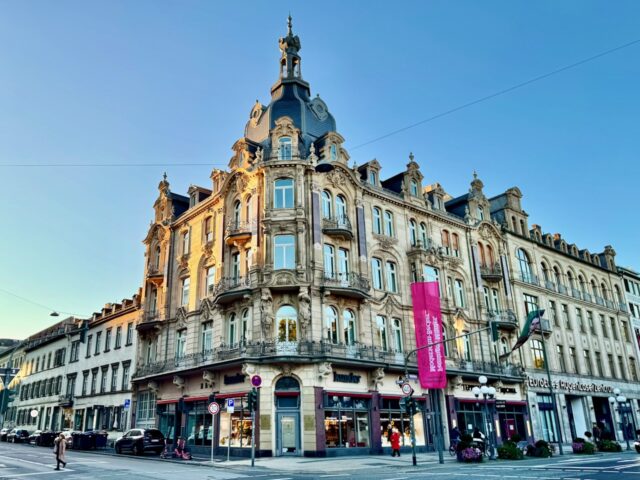 Beautiful architecture in Wiesbaden
Beautiful architecture in Wiesbaden 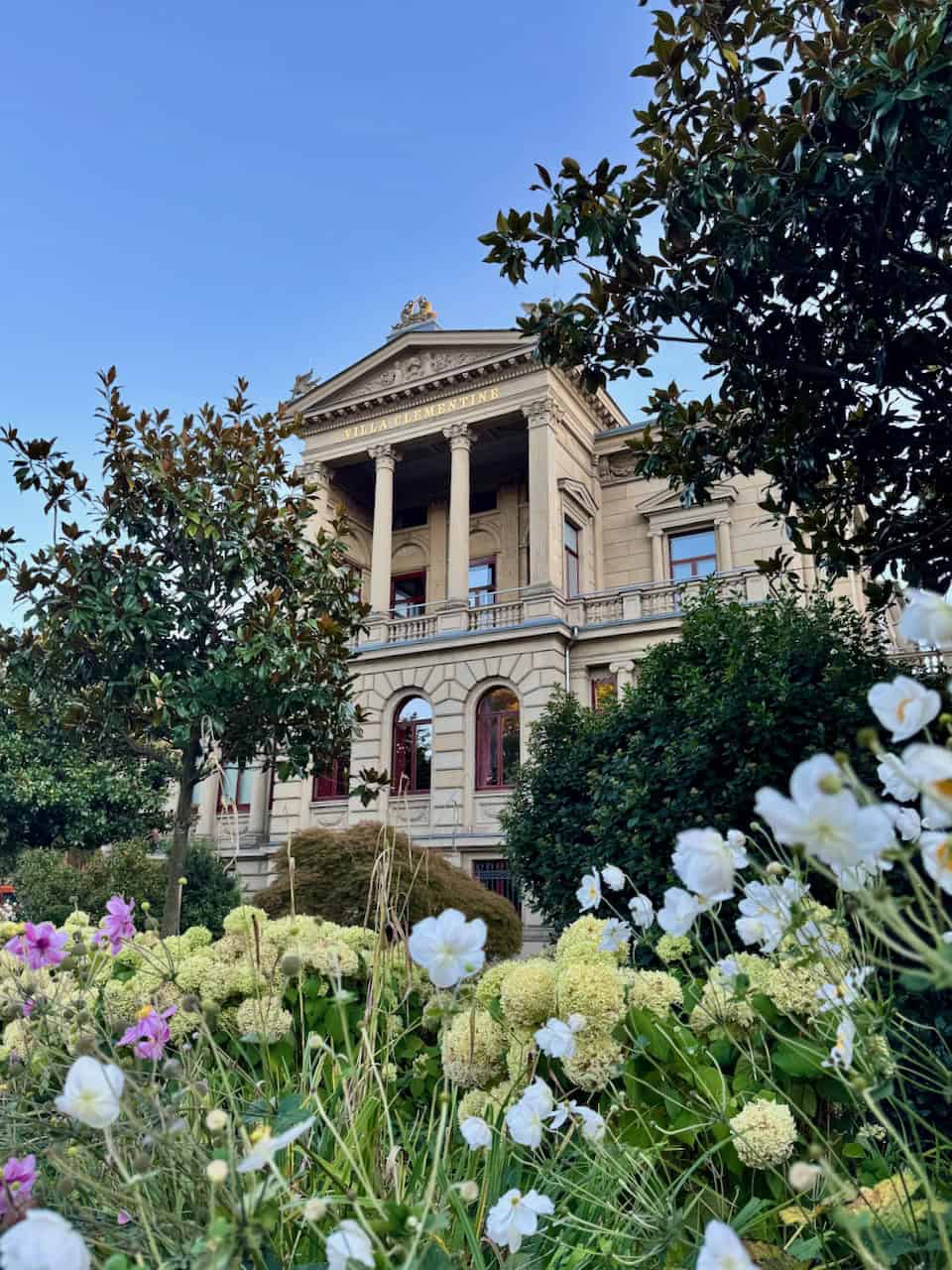 One of the beautiful villas in Wiesbaden
One of the beautiful villas in Wiesbaden 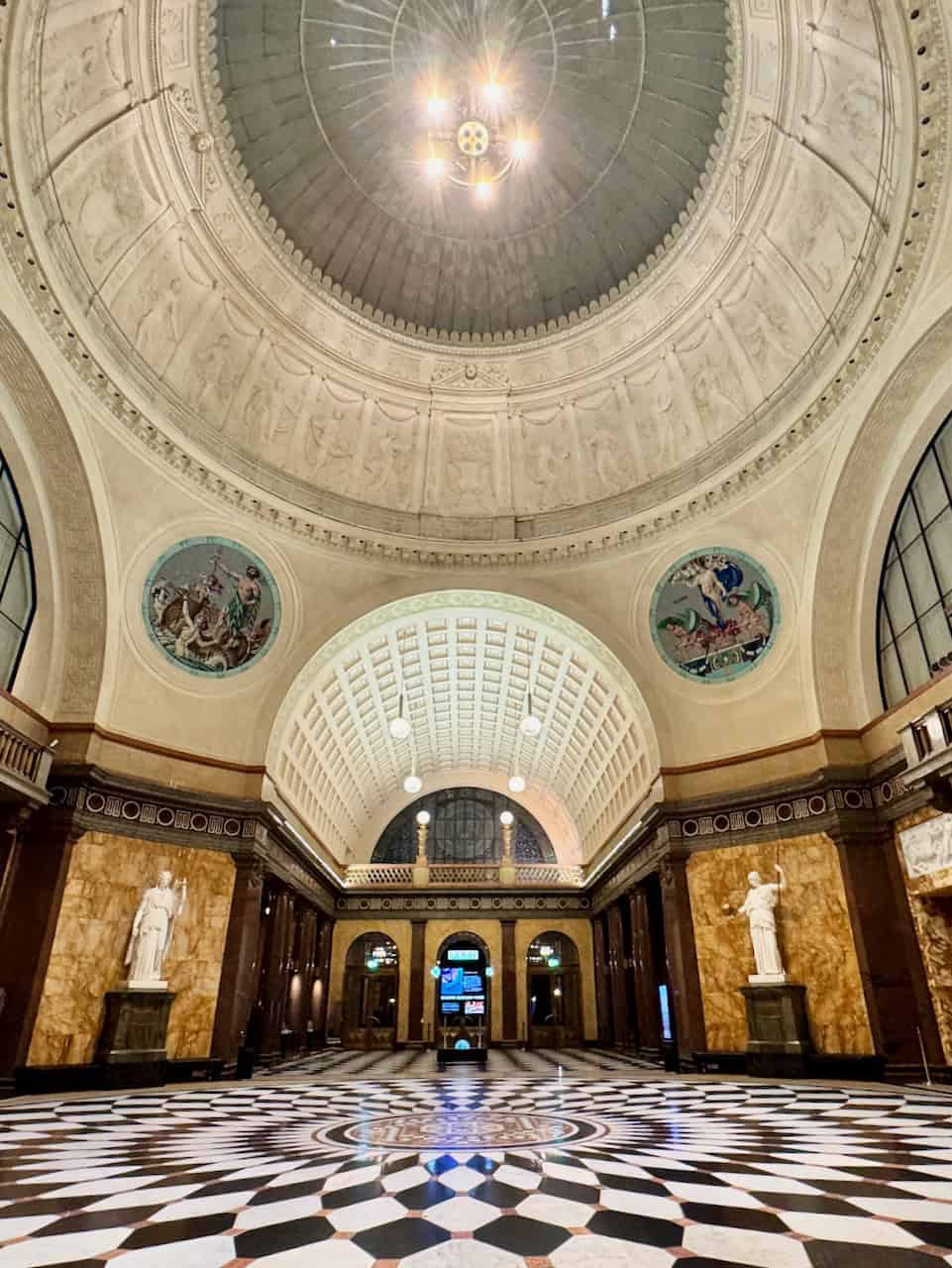 Inside the Kurhaus
Inside the Kurhaus
My next stop was Nerotal, an avenue lined by stunning 19th century villas, each with a unique design. I rode the Nerobergbahn, a historic water-ballast funicular, up to Neroberg (hill). Walking through the thickly forested Neroberg park and enjoying the panoramic view of Wiesbaden at sunset were definitely highlights of my visit.
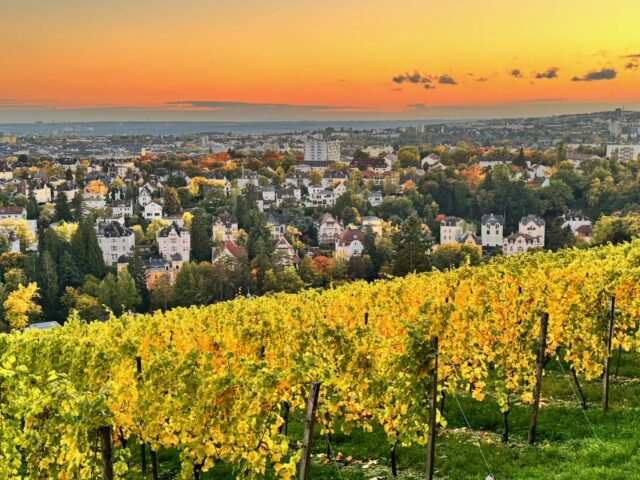 Sunset from Neroberg – notice the gorgeous villas below in Nerotal.
Sunset from Neroberg – notice the gorgeous villas below in Nerotal.
The Neroberg is also home to one of Wiesbaden’s most striking attractions: the Russian Orthodox St. Elizabeth Church. Built in the 1850’s by Duke Adolph of Nassau as a memorial to his late wife, a member of the Russian nobility, the church has earned a reputation as Wiesbaden’s own Taj Mahal.
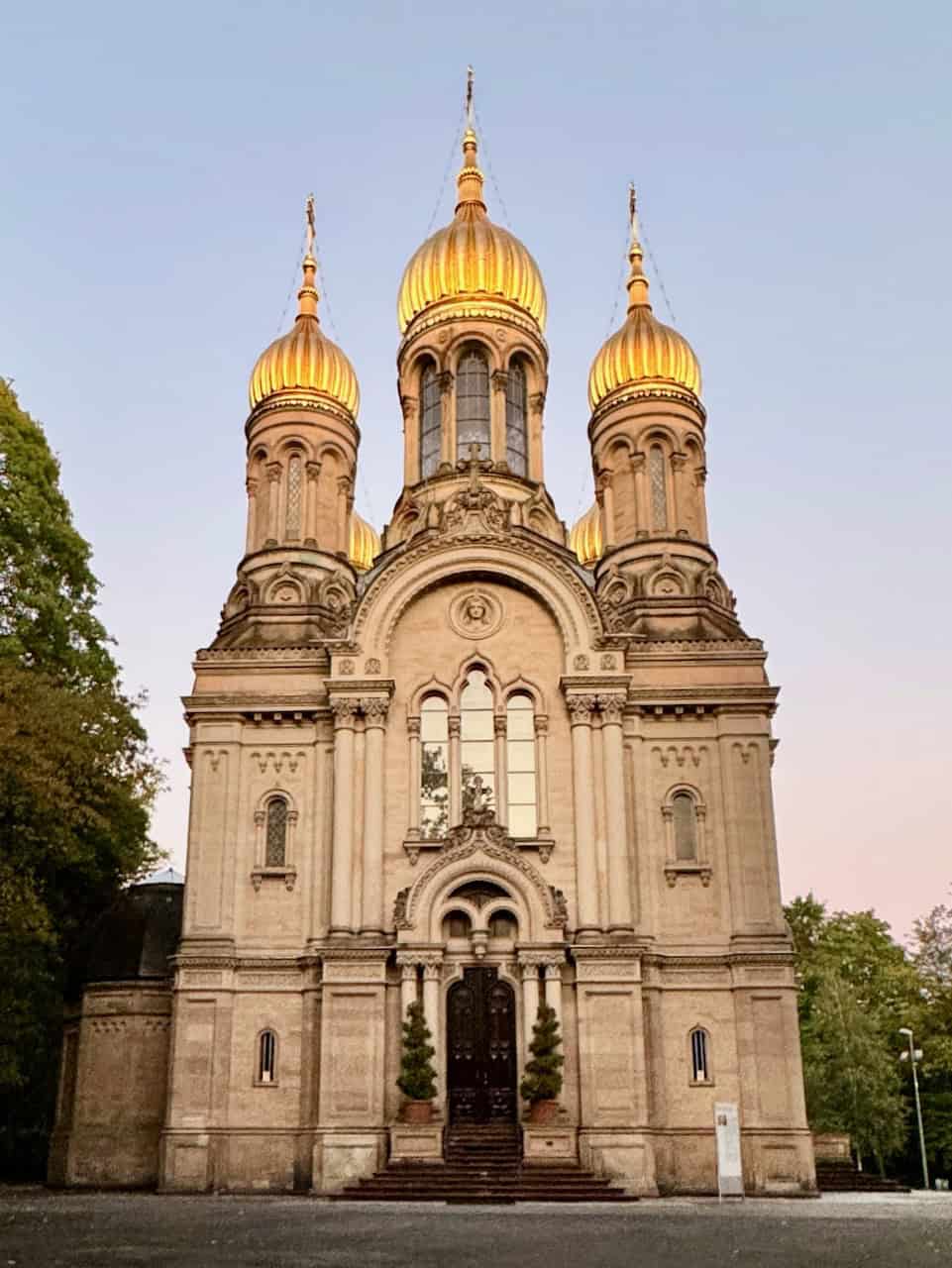 St. Elizabeth Church
St. Elizabeth Church
The following day, I continued my exploration of Wiesbaden by strolling around the historic city centre. The highlights of my stroll include tasting the mineral-rich spring water at the Kochbrunnen and visiting the Market Church. I also enjoyed the delicious lunch at Cafe Maldaner, a gorgeous Viennese-style café that’s famous for its cakes and desserts (though I can also recommend lunch or dinner there). Visit the Wiesbaden Tourism website for more info.
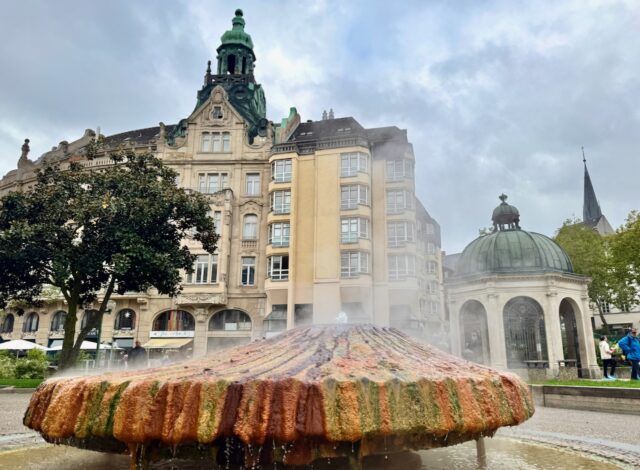 The sulfuric vapors at Kohbrunnen mineral spring
The sulfuric vapors at Kohbrunnen mineral spring 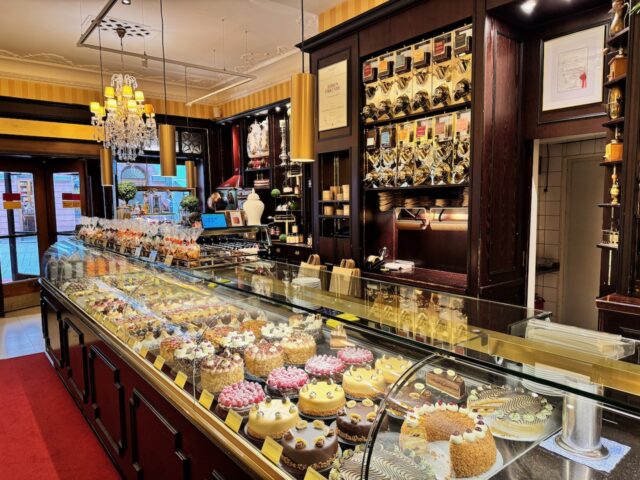 Cafe Maldaner
Cafe Maldaner
The world’s largest producer of sparkling wines
Wiesbaden had one more treat in store for me before I left: a guided tour of the Henkell-Freixenet winery, the world’s largest producer of sparkling wines! This insightful tour included a wine-tasting as well as visits to its cellars and bottling plants.
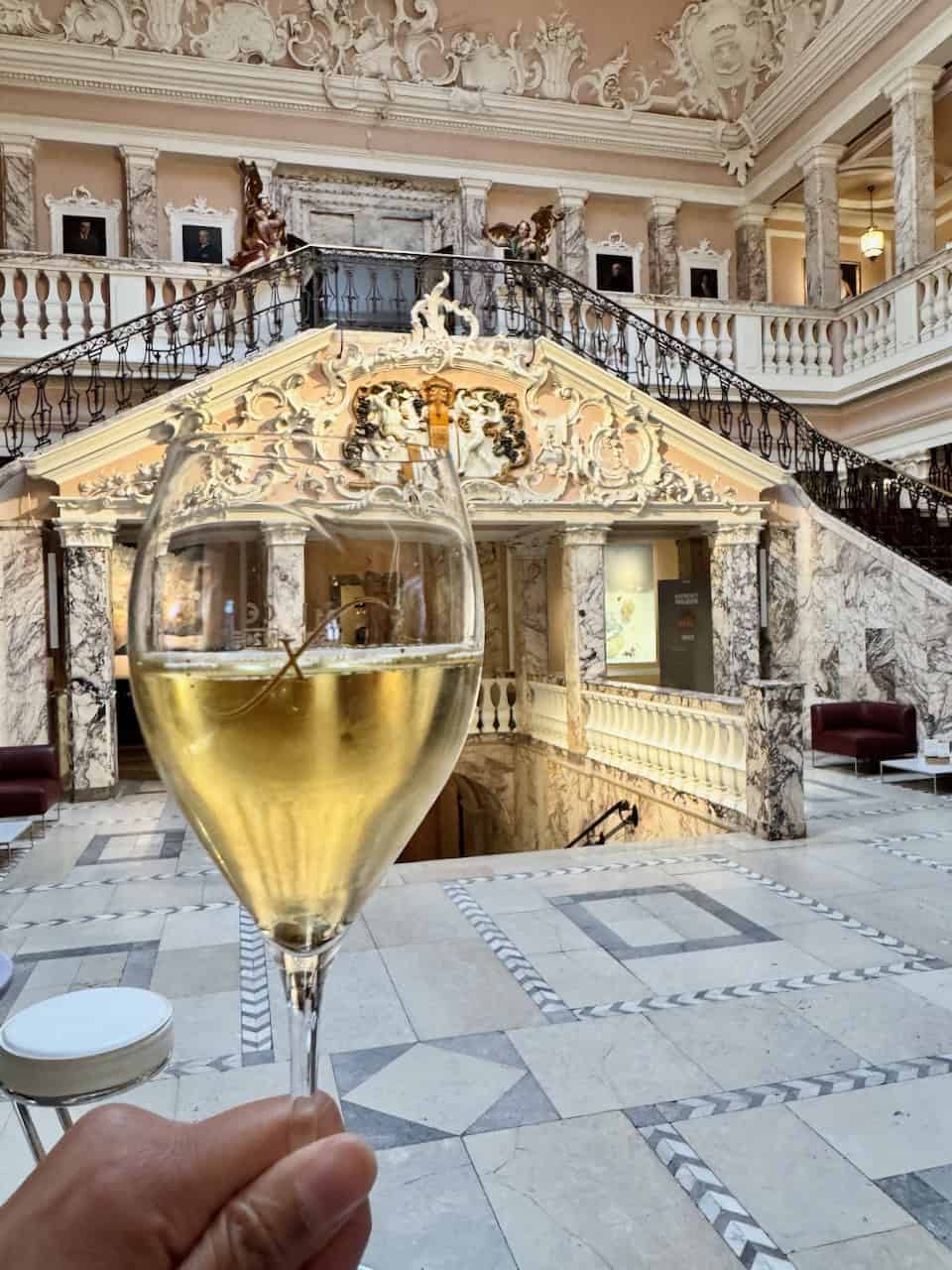 Wine-tasting at the Henkell-Freixenet winery
Wine-tasting at the Henkell-Freixenet winery
I learned about more things to see and do in Wiesbaden. Alas, I had to catch my train back to Amsterdam. I’ll definitely return one day – I left utterly captivated by the city!
Note: this rail tour in western Germany was made possible in partnership with Historic Highlights of Germany. As always, all views expressed above are mine, and mine only.
Please visit:
Our Sponsor
